Table of Contents
- Introduction
- What is Digital Shearography?
- Digital Shearography Process
- Applications of Digital Shearography
- Benefits of Digital Shearography
- Conclusion
- Key Takeaways
- FAQs
Introduction
In the early history of NDT, traditional methods like visual inspection, dye penetrant testing, and ultrasonic testing were employed to test the state of materials, equipment, and structures.
While these methods served their purpose, they were limited in terms of sensitivity in detecting subtle deformations or defects in complex materials.
Shearography, a technique that measures surface strain and deformation, emerged as a promising solution in the mid-20th century.
This method involved applying a Shearographic interferometer to record and assess the interference patterns resulting from surface changes.
Despite its effectiveness, early Shearography systems possessed limited resolution and difficulties in real-time monitoring.
With technological advancements, the need for more sophisticated NDT Methods became evident.
This led to the evolution of digital Shearography which represented a significant advancement over its analog predecessor.
Digital Shearography systems, equipped with high-resolution cameras and advanced imaging sensors, enhanced the sensitivity to surface changes.
This allowed for the detection of even minute deformations.
The shift to digital systems facilitated more precise analysis of fringe patterns through sophisticated algorithms and digital processing NDT Techniques.
Digital Shearography brought about real-time monitoring capabilities, providing instant feedback during inspections.
This feature was particularly crucial for time-sensitive applications.
With a particular focus on composite materials, digital Shearography found extensive applications in industries such as aerospace, automotive, and oil & gas.
The demand for more reliable and efficient NDT Methods in these industries drove the adoption of Digital Shearography.
Digital Shearography gradually replaced analog Shearography systems in many applications due to its superior capabilities, precision, and ability to meet the evolving demands of modern industries.
What is Digital Shearography?
Digital Shearography is a Non-destructive Testing (NDT) Method that utilizes laser technology for the identification and assessment of surface defects and deformities present in materials under testing.
Digital Shearography involves applying a Shearographic Interferometer to the material's surface.
This interferometer captures the deformation patterns caused by stress or defects, producing fringe patterns that are then analyzed digitally.
This NDT Method is efficient in discerning errors like crack, inclusion, delaminations, etc.
The features of Digital Shearography allow for it to be used to inspect large test areas, which helped in the rise of the method as a trusted testing methodology in industries.
Its NDT nature aided in making it a preferred method.
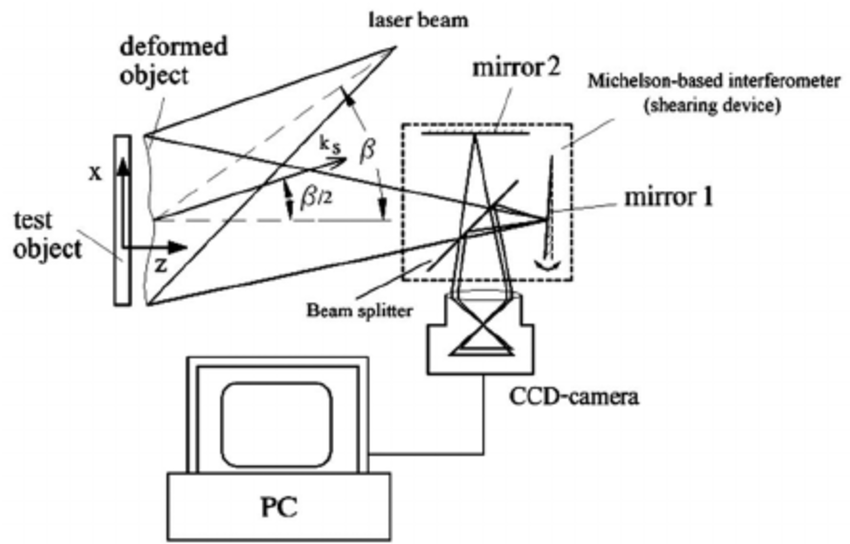
Digital Shearography Process
The process begins with the initialization of the digital Shearography system.
1. Shearographic Interferometer Application:
A Shearographic interferometer, a key component of the system, is applied to the material's surface under inspection.
The Shearographic interferometer emits laser light onto the material's surface.
The laser light interacts with the material's surface, creating an interference pattern.
The Shearographic interferometer captures real-time deformation patterns caused by stress, strain, or defects in the material.
The captured deformation patterns are transformed into fringe patterns. This transformation is often achieved through optical components within the system.
Fringe patterns are digitally imaged or recorded using cameras or other optical sensors.
The digital images of fringe patterns are subjected to advanced digital analysis.
Algorithms and processing techniques are applied to analyze the fringe patterns in detail.
The analysis process identifies variations in the fringe patterns, pinpointing areas of the material where deformations, defects, or anomalies are present.
The results are translated into a visual representation, often displayed on a computer screen.
The system provides real-time monitoring, allowing for immediate feedback during the inspection process.
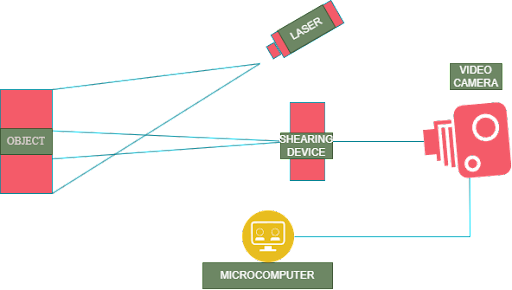
Principle of Digital Shearography
The principles of digital Shearography involve the application of interferometry to detect and analyze surface deformations in materials.
Here are the key principles of digital Shearography include the following:
1. Interferometry Foundation:
Digital Shearography, grounded in interferometry principles, is a cornerstone in Non-destructive Evaluation (NDE) for NDT professionals.
2. Shearographic Interferometer Application:
Applied in digital shearography testing, the Shearographic Interferometer detects surface changes, offering precise results crucial for NDT Techniques and composite testing.
3. Deformation Pattern Capture:
Real-time capture of deformation patterns, induced by stress or defects, enhances the sensitivity of digital Shearography in identifying anomalies critical for NDT Professionals and inspections.
4. Transformation into Fringe Patterns:
The transformation of deformation patterns into fringe patterns, digitally analyzed, ensures detailed insights for NDT Technicians involved in digital Shearography inspection.
5. Digital Imaging:
High-resolution digital imaging of fringe patterns, a hallmark of digital Shearography NDT, facilitates detailed analysis by NDT professionals in the Oil and Gas Industry and other sectors.
6. Digital Analysis Techniques:
Employing advanced digital analysis techniques, digital Shearography excels in the precise identification and characterization of defects, aligning with the Principles of Non-destructive Testing.
7. High Sensitivity to Surface Changes:
Renowned for its high sensitivity to surface changes, digital Shearography is indispensable for detecting subtle deformations in materials, meeting the demands of NDT Methods.
8. Real-Time Monitoring:
Real-time monitoring capabilities inherent in digital Shearography systems empower NDT Professionals with immediate feedback during inspections, contributing to efficient workflows in NDT testing.
9. Non-Destructive Nature:
The non-destructive nature of digital Shearography, aligned with the ethos of Non-Destructive Evaluation, safeguards material integrity during the inspection process.
With its versatility, Digital Shearography is proficient in detecting defects such as delaminations and cracks, making it a preferred choice for NDT testing across industries.
Seamlessly integrated into manufacturing processes, Digital Shearography NDT systems contribute to in-line inspection, aligning with the efficiency demands of NDT Professionals.
Digital shearography's real-time capabilities extend to the monitoring of dynamic material behavior, catering to the nuanced requirements of NDT Techniques in diverse engineering applications.
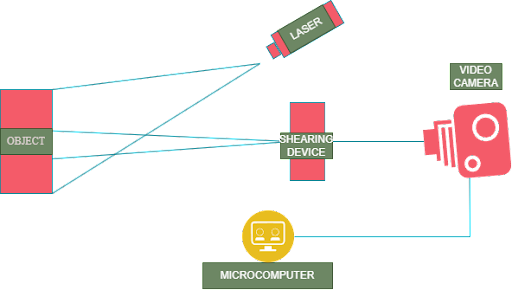
Applications of Digital Shearography
Digital Shearography is an advanced method that, when intertwined with NDT Techniques, holds versatile applications.
From aerospace to the Oil and gas Industry, digital shearography's precision detects defects, ensuring structural integrity in diverse materials and industries.
Some of the applications include the following:
1. Aerospace Industry:
Composite testing in aircraft components is performed using digital Shearography.
Digital Shearography is used for the detection of delaminations, impact damage, and bonding defects in composite structures, showcasing the precision of digital Shearography in NDT Testing for aerospace.
2. Automotive Industry:
Digital Shearography is used in the inspection of composite materials in vehicle components for the identification of defects like voids, disbands, and impact damage.
3. Manufacturing Industry:
In-line inspection during manufacturing processes is performed using digital Shearography for the detection of surface defects, including cracks and deformations, showcasing the real-time monitoring capabilities of digital Shearography.
4. Oil & Gas Industry:
Digital Shearography is used for inspection in the Oil and Gas Industry for pipelines, Pressure Vessels, and composite materials for the identification of defects such as corrosion, stress-related anomalies, and structural integrity issues.
5. Renewable Energy:
Digital Shearography is used for the inspection of composite materials in wind turbine blades to detect delaminations, bond quality, and manufacturing defects affecting the structural integrity of turbine blades.
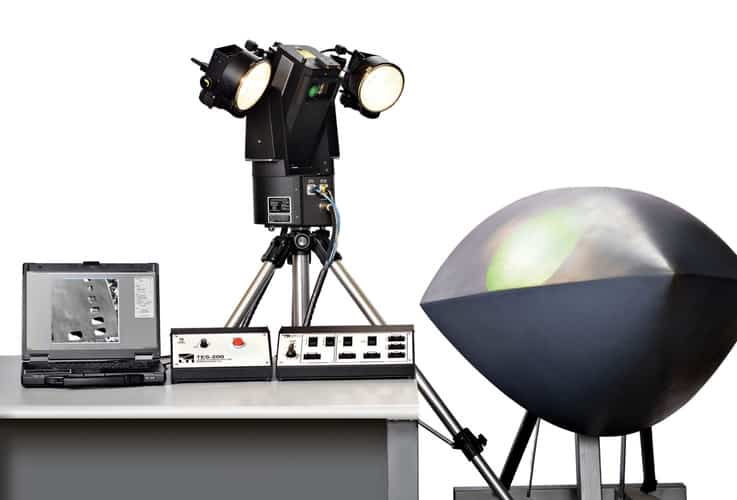
6. Infrastructure Inspection:
Structural health monitoring of bridges and buildings is performed with Digital Shearography for the identification of defects like cracks, deformations, and material anomalies.
7. Marine Industry:
Digital Shearography is used in the inspection of composite materials in ship structures for the detection of delaminations, impact damage, and bonding defects.
8. Power Generation Industry:
Inspection of critical components in power plants is performed using Digital Shearography in the identification of defects such as stress-related anomalies, corrosion, and structural issues.
9. Rail Industry:
Digital Shearography is used in the inspection of composite materials in rail components.
It detects defects like delaminations, impact damage, and manufacturing anomalies.
10. Electronics Industry:
Digital Shearography is used in the inspection of electronic components and circuit boards.
It detects defects like solder joint cracks, material deformations, and manufacturing discrepancies.
Benefits of Digital Shearography
The advantages of Digital Shearography include the following factors:
1. High Sensitivity:
Digital Shearography systems exhibit high sensitivity, making them ideal for intricate NDT Applications such as digital Shearography NDT.
2. Real-Time Monitoring:
Real-time monitoring capabilities inherent in digital Shearography systems enhance efficiency in digital Shearography testing and inspection processes.
3. Versatility in Composite Testing:
Digital Shearography excels in composite testing, proving invaluable for digital Shearography composite testing applications.
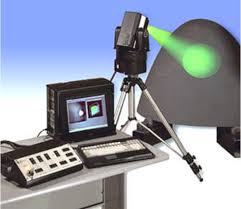
4. Precise Defect Detection:
The precision of digital Shearography ensures the accurate detection of defects, crucial in maintaining the integrity of materials subjected to digital Shearography inspection.
5. Non-Destructive Nature:
Digital Shearography is inherently non-destructive, preserving the structural integrity of materials during digital Shearography testing.
6. Automated Analysis:
Digital Shearography systems facilitate automated analysis, streamlining the interpretation of data in digital Shearography NDT Processes.
7. High-Resolution Imaging:
The high-resolution imaging capabilities of digital Shearography systems contribute to detailed defect characterization in digital Shearography inspection.
8. Dynamic Material Monitoring:
Digital Shearography allows for dynamic material monitoring, a key advantage for applications where real-time insights are crucial, such as digital Shearography testing in the Oil and Gas Industry.
9. Efficient Integration into Manufacturing:
Seamless integration into manufacturing processes showcases the efficiency of digital Shearography systems, ensuring in-line inspection during digital Shearography composite testing.
10. Enhanced Safety in NDT:
The non-destructive nature and precision of digital Shearography contribute to enhanced safety in NDT Processes, particularly in critical applications like digital Shearography inspection in the oil & gas industry.
Conclusion
Digital Shearography offers unmatched sensitivity, real-time testing prowess, and precise defect detection that redefine industry standards.
As we look ahead, the future scope of Digital Shearography holds promising developments, driven by NDT Technological Advancements.
Anticipated improvements in sensor technologies, data analytics, and Artificial Intelligence are poised to elevate the precision and efficiency of Digital Shearography systems.
This evolving landscape foresees an era where Digital Shearography not only continues to excel in composite testing and inspection but also expands its application horizon to address even more complex material challenges.
The seamless integration into manufacturing processes will become more sophisticated, ensuring that Digital Shearography remains at the forefront of NDT Methodologies.
The engineering industry is on the cusp of a transformative era, with Digital Shearography as a guiding force, promising enhanced methodologies, and heightened material scrutiny in the years to come.
Key Takeaways
- A cutting-edge methodology leveraging interferometry, Digital Shearography offers unmatched sensitivity, real-time monitoring, and precise defect detection, revolutionizing Non-destructive Testing Applications across industries from aerospace to oil & gas.
- Beyond its current applications, Digital Shearography's versatility holds promise for future advancements. Anticipated developments in sensor tech and AI are poised to enhance precision, streamline workflows, and expand applications across diverse engineering challenges.
FAQs:
1. What is the use of Digital Holography?
A: Digital holography is a Non-destructive Testing Method used to document and create 3-D images of objects and finds applications in a variety of fields such as microscopy, interferometry, medical imaging, and data storage.
In non-destructive testing (NDT), it enables the visualization and assessment of internal structures without physical contact.
2. What are the disadvantages of digital holography?
A: While a potent technique, digital holography has drawbacks.
It can be sensitive to environmental conditions like vibrations, demanding stable setups.
Computational requirements for reconstruction may be high, and holographic recordings might be prone to noise, impacting overall image quality.
3. What is the difference between Shearography and holography?
A: Shearography and holography, both optical Techniques in NDT, differ in their focus.
Shearography specifically examines surface deformations caused by stress or defects, whereas holography records interference patterns between reference and object waves, generating a three-dimensional representation of the entire object.
4. What are the different types of Shearography?
A: Electronic Shearography: Applies electronic speckle pattern interferometry to detect surface deformations, providing insights into material conditions.
Phase-Shift Shearography: Introduces phase shifts in the reference beam to enhance measurement quality and accuracy, particularly beneficial for quantitative analysis.
Temporal Shearography: Utilizes variations in object loading or temperature over time, enabling the detection of dynamic deformations or anomalies.
Pulsed Shearography: Incorporates pulsed lasers for object illumination, capturing high-speed deformation information, making it suitable for dynamic testing applications.









